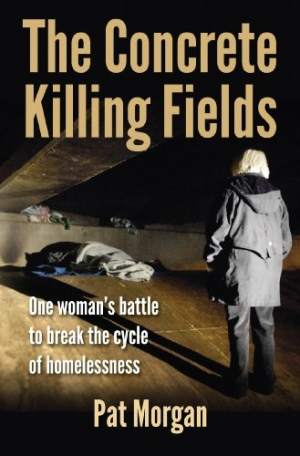The Concrete Killing Fields
One Woman's Battle to Break the Cycle of Homelessness
The blend of memoir and case study balances well and provides a striking portrait of both sides of a homeless shelter.
A blend of memoir, social advocacy, and stories about homeless men in Memphis, Tennessee, The Concrete Killing Fields is at once deeply personal and broadly drawn. By delving into the reasons behind homelessness of the individuals she meets, Pat Morgan presents intriguing conclusions about issues related to mental health, government policy, and our social safety net.
A political insider who once interned for Senator Al Gore and worked on Bill Clinton’s presidential campaign, Morgan settled in Memphis in a bid to save her second marriage and soon found herself volunteering at her church, helping homeless men find shelter and other resources. She soon found the experience to be life-changing and started documenting their stories as a way toward understanding their situations.
As Morgan recollects on her decision to become involved with the homeless, she begins to muse on her upbringing in the South, as the daughter of a police officer and a resident of a very small town. She’s able to draw a number of parallels between what she experienced as a child—the support of the community, the nascent understanding of alcoholism, the excitement of sitting in her father’s police car as he waited for trouble—and the paths that later drew her into social work. She weaves in her later difficulties (divorce and raising children as a single mother), providing a unique perspective on how the events of her past brought her to working with the homeless.
Perhaps most compelling, Morgan doesn’t hold back about the frustrations of working not just with the system, but with the homeless themselves. Although she’s always respectful in her descriptions of their mental issues and addictions, she is transformed from a wide-eyed volunteer to an advocate who sees far more shades of gray in the “concrete killing fields” around her.
The author even proposes a “Twelve Steps for Do-Gooders” based on the model followed by Alcoholics Anonymous. This powerful document, delivered with concision, artfully describes the difficult balance that many advocates and social workers must strike in order to be truly helpful. In step four, for example, she writes, “Made a searching and fearless moral inventory of myself and the ‘help’ I was trying to provide to others, often rendered unrecognizable because of my frustration and anger at the very people I wanted so much to help.”
Where the book shines the brightest is in Morgan’s descriptions of those very individuals. Her writing style is straightforward and conversational, as if she’s telling each story to a rapt audience.
Reviewed by
Elizabeth Millard
Disclosure: This article is not an endorsement, but a review. The publisher of this book provided free copies of the book to have their book reviewed by a professional reviewer. No fee was paid by the publisher for this review. Foreword Reviews only recommends books that we love. Foreword Magazine, Inc. is disclosing this in accordance with the Federal Trade Commission’s 16 CFR, Part 255.

